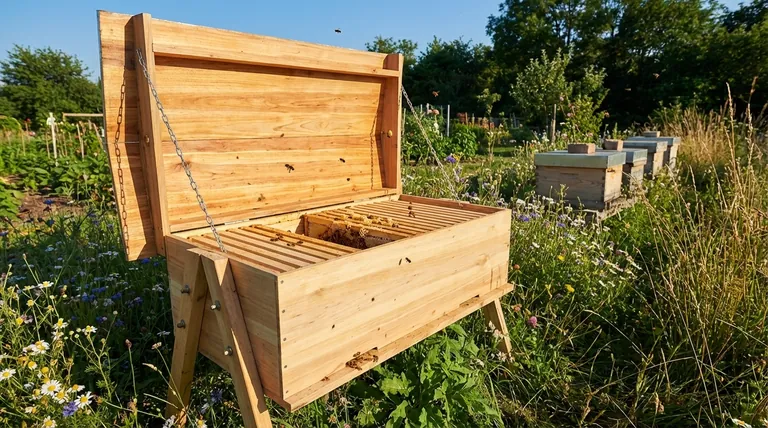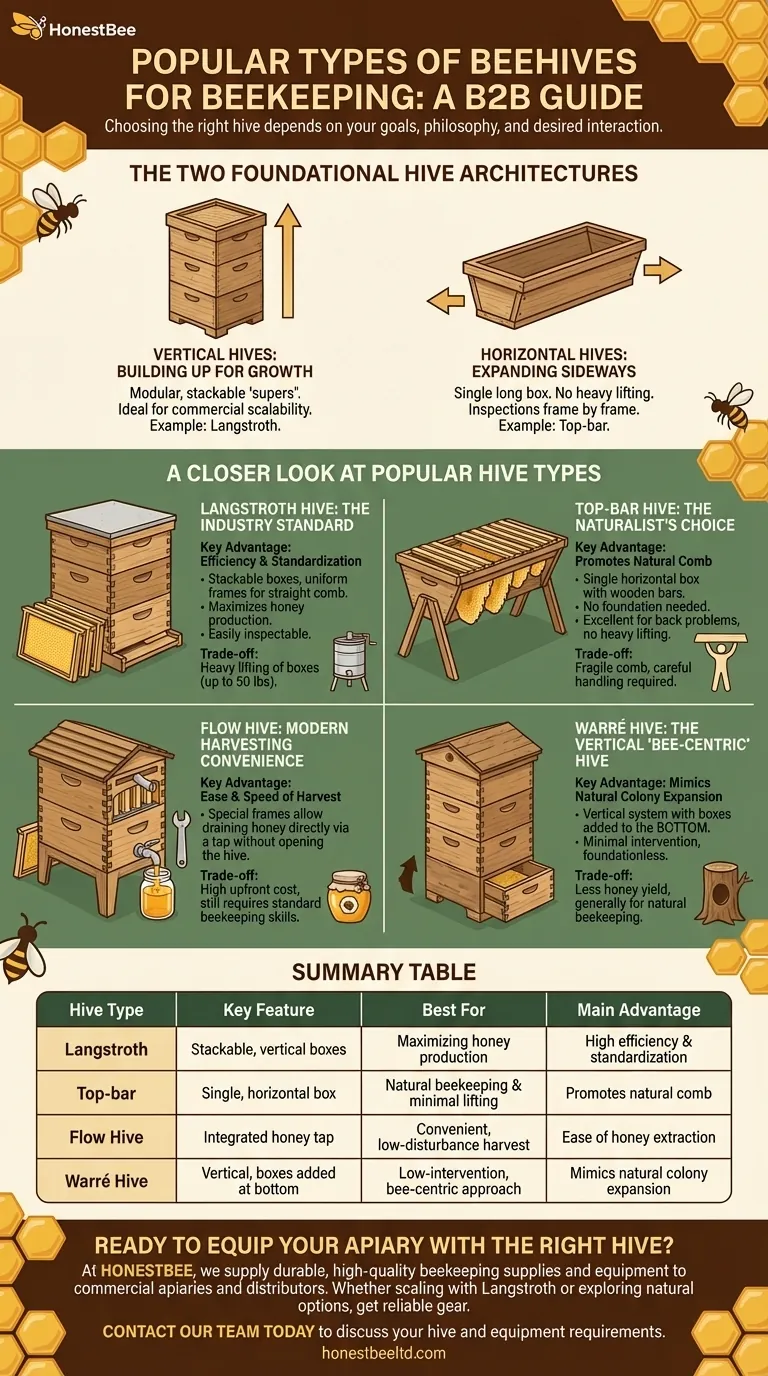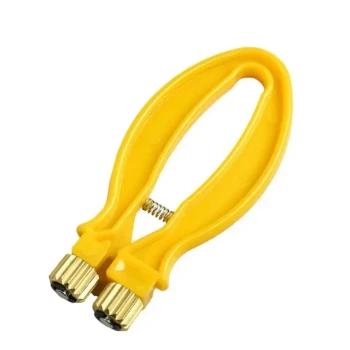When choosing a home for your bees, you will find several well-established designs, each rooted in a specific beekeeping philosophy. The most popular beehives used today are the Langstroth, the Top-bar, and modern variations like the Flow Hive. Your choice among them will be determined by your goals, physical ability, and how you wish to interact with your bees.
The "best" beehive does not exist. The right choice depends entirely on your primary goal, whether it's maximizing honey production, practicing a more natural and less-intrusive style of beekeeping, or prioritizing ease of harvest.

The Two Foundational Hive Architectures
Before examining specific models, it's crucial to understand the two fundamental design principles: vertical and horizontal hives. This distinction dictates how you will manage the colony and its space.
Vertical Hives: Building Up for Growth
Vertical hives are modular and expand upwards. They consist of a series of stackable boxes, typically called "supers." As the colony grows and needs more space for brood or honey, you add more boxes on top.
The Langstroth is the quintessential vertical hive. This design is the global standard for commercial operations precisely because it is so scalable.
Horizontal Hives: Expanding Sideways
Horizontal hives consist of one single, long box. The colony starts at one end and expands sideways as it grows.
This design, exemplified by the Top-bar hive, means you never have to lift heavy, honey-filled boxes. All inspections are done by removing one frame at a time from the top.
A Closer Look at Popular Hive Types
Each hive model offers a distinct set of features, benefits, and challenges. Understanding these differences is key to making an informed decision.
The Langstroth Hive: The Industry Standard
The Langstroth is the most recognizable beehive in the world. It is composed of stacked boxes containing frames that hold either a plastic or wax foundation, which guides the bees in building straight, even comb.
Its key advantage is efficiency and standardization. Parts are interchangeable and widely available. This design is optimized for ease of inspection and maximizing honey production.
The Top-bar Hive: The Naturalist's Choice
A Top-bar hive is a single, horizontal trough with simple wooden bars laid across the top. The bees build their comb directly down from these bars without any pre-made foundation.
This hive appeals to beekeepers wanting a more "natural" or treatment-free approach. Because there is no heavy lifting of supers, it is also an excellent choice for those with back problems.
The Flow Hive: Modern Harvesting Convenience
The Flow Hive is a modified Langstroth hive that features special honey-storage frames. These frames allow you to drain the honey directly into a jar via a tap, without opening the hive or disturbing the bees.
Its primary benefit is the ease and speed of harvest. However, it is a significant financial investment, and a beekeeper must still learn all the fundamentals of hive inspection and bee health, as the Flow frames only replace the honey extraction process.
The Warré Hive: The Vertical "Bee-Centric" Hive
The Warré (pronounced war-RAY) hive is a vertical hive designed for minimal beekeeper intervention. It uses smaller boxes than a Langstroth and, like a Top-bar, is typically foundationless.
Its unique feature is that new boxes are added to the bottom, not the top. This mimics the way a bee colony would expand downwards in a natural cavity like a hollow tree.
Understanding the Trade-offs
No single hive is perfect for every person or situation. Your choice involves balancing key factors.
Honey Production vs. Natural Comb
Langstroth hives with foundation are engineered for maximum, efficient honey production. The uniform combs are easily spun in an extractor.
Top-bar and Warré hives produce beautiful, natural comb but generally yield less honey. The delicate, foundationless comb cannot be spun in a standard extractor and is typically crushed and strained to harvest the honey.
Ease of Management vs. Physical Effort
Langstroth hive management is straightforward due to standardized parts, but it requires lifting boxes that can weigh over 50 pounds (23 kg).
Top-bar hives eliminate heavy lifting entirely. However, the foundationless combs are more fragile and require careful handling during inspections to prevent them from breaking.
Upfront Cost and Accessibility
Langstroth components are ubiquitous and generally the most affordable. Top-bar hives are simple enough that they are often a popular DIY project, potentially making them the cheapest option.
Flow Hives represent the highest upfront cost due to their patented honey-draining technology.
Making the Right Choice for Your Goal
Your choice of hive sets the tone for your entire beekeeping experience. Base your decision on your primary motivation for keeping bees.
- If your primary focus is maximizing honey production: The Langstroth hive is the undisputed standard due to its efficiency and scalability.
- If your primary focus is natural beekeeping with minimal heavy lifting: The Top-bar hive is an excellent choice that promotes natural comb and is easier on your back.
- If your primary focus is convenience and a less disruptive harvest: The Flow Hive offers a revolutionary solution, but be prepared for a higher initial investment and the need to master standard beekeeping skills.
- If your primary focus is a low-intervention, "bee-centric" approach: The Warré hive provides a compelling vertical system that mimics a bee colony's natural instincts.
Choosing a hive is the first step in a fascinating journey, so align your equipment with your personal philosophy from the very beginning.
Summary Table:
| Hive Type | Key Feature | Best For | Main Advantage |
|---|---|---|---|
| Langstroth | Stackable, vertical boxes | Maximizing honey production | High efficiency & standardization |
| Top-bar | Single, horizontal box | Natural beekeeping & minimal lifting | Promotes natural comb |
| Flow Hive | Integrated honey tap | Convenient, low-disturbance harvest | Ease of honey extraction |
| Warré Hive | Vertical, boxes added at bottom | Low-intervention, bee-centric approach | Mimics natural colony expansion |
Ready to equip your apiary with the right hive?
At HONESTBEE, we supply durable, high-quality beekeeping supplies and equipment to commercial apiaries and beekeeping equipment distributors. Whether you're scaling up with Langstroth systems or exploring natural options, our wholesale-focused operations ensure you get the reliable gear you need to support healthy, productive colonies.
Contact our team today to discuss your hive and equipment requirements.
Visual Guide

Related Products
- Long Langstroth Style Horizontal Top Bar Hive for Wholesale
- Multi-Function Hive Tool with Integrated Hammer for Beekeeping
- Professional Drop-Style Hive Handles for Beekeeping
- Premium Comfort Grip Spring-Loaded Hive Handles
- Professional Galvanized Hive Strap with Secure Locking Buckle for Beekeeping
People Also Ask
- What are the benefits of the top bar hive? A Guide to Ergonomic, Natural Beekeeping
- What are the box management requirements for a top bar hive vs. Langstroth? Choose Your Hive Strategy
- How are entrances designed in top bar hives? Master Beehive Layout for Maximum Honey
- What are the advantages of a top bar hive? Simpler, Bee-Centric Beekeeping for All
- What is a top bar bee hive? A Natural, Low-Stress Beekeeping Solution



















